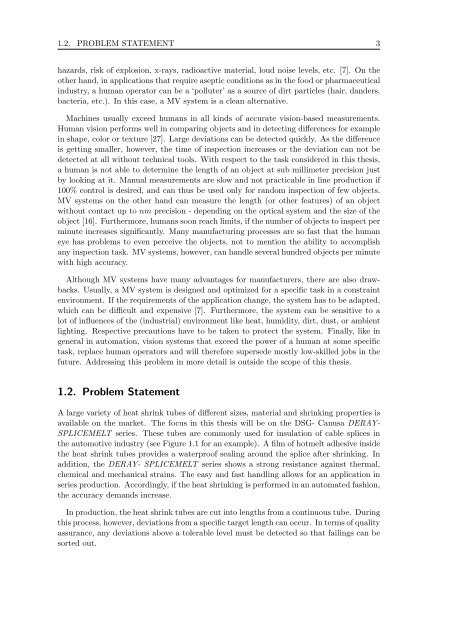Master Thesis - Fachbereich Informatik
Master Thesis - Fachbereich Informatik
Master Thesis - Fachbereich Informatik
Create successful ePaper yourself
Turn your PDF publications into a flip-book with our unique Google optimized e-Paper software.
1.2. PROBLEM STATEMENT 3<br />
hazards, risk of explosion, x-rays, radioactive material, loud noise levels, etc. [7]. On the<br />
other hand, in applications that require aseptic conditions as in the food or pharmaceutical<br />
industry, a human operator can be a ‘polluter’ as a source of dirt particles (hair, danders,<br />
bacteria, etc.). In this case, a MV system is a clean alternative.<br />
Machines usually exceed humans in all kinds of accurate vision-based measurements.<br />
Human vision performs well in comparing objects and in detecting differences for example<br />
in shape, color or texture [27]. Large deviations can be detected quickly. As the difference<br />
is getting smaller, however, the time of inspection increases or the deviation can not be<br />
detected at all without technical tools. With respect to the task considered in this thesis,<br />
a human is not able to determine the length of an object at sub millimeter precision just<br />
by looking at it. Manual measurements are slow and not practicable in line production if<br />
100% control is desired, and can thus be used only for random inspection of few objects.<br />
MV systems on the other hand can measure the length (or other features) of an object<br />
without contact up to nm precision - depending on the optical system and the size of the<br />
object [16]. Furthermore, humans soon reach limits, if the number of objects to inspect per<br />
minute increases significantly. Many manufacturing processes are so fast that the human<br />
eye has problems to even perceive the objects, not to mention the ability to accomplish<br />
any inspection task. MV systems, however, can handle several hundred objects per minute<br />
with high accuracy.<br />
Although MV systems have many advantages for manufacturers, there are also drawbacks.<br />
Usually, a MV system is designed and optimized for a specific task in a constraint<br />
environment. If the requirements of the application change, the system has to be adapted,<br />
which can be difficult and expensive [7]. Furthermore, the system can be sensitive to a<br />
lot of influences of the (industrial) environment like heat, humidity, dirt, dust, or ambient<br />
lighting. Respective precautions have to be taken to protect the system. Finally, like in<br />
general in automation, vision systems that exceed the power of a human at some specific<br />
task, replace human operators and will therefore supersede mostly low-skilled jobs in the<br />
future. Addressing this problem in more detail is outside the scope of this thesis.<br />
1.2. Problem Statement<br />
A large variety of heat shrink tubes of different sizes, material and shrinking properties is<br />
available on the market. The focus in this thesis will be on the DSG- Canusa DERAY-<br />
SPLICEMELT series. These tubes are commonly used for insulation of cable splices in<br />
the automotive industry (see Figure 1.1 for an example). A film of hotmelt adhesive inside<br />
the heat shrink tubes provides a waterproof sealing around the splice after shrinking. In<br />
addition, the DERAY- SPLICEMELT series shows a strong resistance against thermal,<br />
chemical and mechanical strains. The easy and fast handling allows for an application in<br />
series production. Accordingly, if the heat shrinking is performed in an automated fashion,<br />
the accuracy demands increase.<br />
In production, the heat shrink tubes are cut into lengths from a continuous tube. During<br />
this process, however, deviations from a specific target length can occur. In terms of quality<br />
assurance, any deviations above a tolerable level must be detected so that failings can be<br />
sorted out.














